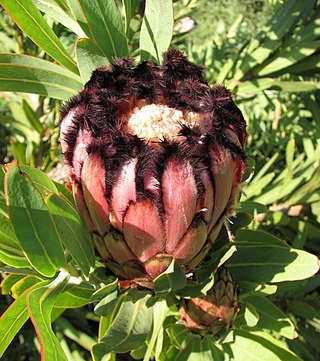
Protea neriifolia, also known as the narrow-leaf sugarbush, oleander-leaved sugarbush, blue sugarbush, or the oleanderleaf protea, is a flowering plant in the genus Protea, which is endemic to South Africa.
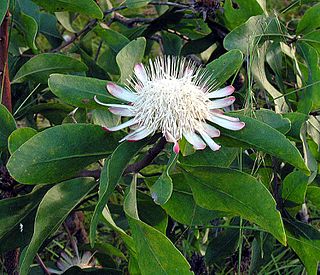
Protea gaguedi is a species of tree which belongs to the genus Protea.

Protea laurifolia, also known as the grey-leaf sugarbush, is a shrub from South Africa. It is native to the Cape Provinces of South Africa.

Protea acaulos, also known as the common ground sugarbush, is a flowering plant found in the southwestern Cape Region, South Africa. It is also simply known as ground protea; in the Afrikaans language it is known as an aardroos.

Protea effusa, sometimes known as the scarlet sugarbush, is a flowering plant which belongs to the genus Protea. The plant is endemic to the Western Cape province of South Africa. In the Afrikaans language the vernacular name blosrooisuikerbos has been recorded for this plant.

Protea namaquana, also known as the Kamiesberg sugarbush, is a flowering plant which belongs to the genus Protea. The plant is endemic to the southwestern Cape Region of South Africa, in particular the Kamiesberg mountains of Namaqualand in the Northern Cape province. The species has a worldwide distribution of only 18 km2. It is regarded as critically endangered. In the Afrikaans language it has the vernacular name is Kamiesbergsuikerbos.

Protea pendula, also known as the nodding sugarbush or arid sugarbush, is a flowering plant of the genus Protea, in the family Proteaceae, which is only found growing in the wild in the Cape Region of South Africa. In the Afrikaans language it is known as knikkopsuikerbossie or ondersteboknopprotea.

Protea recondita, also known as the hidden sugarbush, is a flowering plant of the genus Protea within the family Proteaceae, which is endemic to the Cape Region of South Africa, and distributed from the Piketberg and Cederberg to the Groot Winterhoek mountains. The flowers of this unusual plant are pollinated by non-flying mammals: rodents and elephant shrews. In the Afrikaans language it is known as gesigtoehouprotea or skaamroos.

Protea sulphurea, also known as the sulphur sugarbush, is a flowering plant of the genus Protea in the family Proteaceae, which is only known to grow in the wild in the Western Cape province of South Africa. A vernacular name for the plant in the Afrikaans language is heuningkoeksuikerbos or Skaamblom.
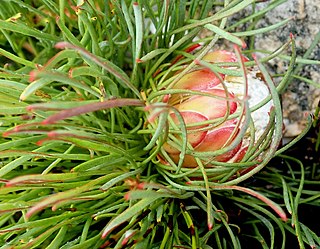
Protea montana also known as the Swartberg sugarbush, is a flowering plant of the genus Protea within the family Proteaceae, which is endemic to the southwestern Cape Region of South Africa. In Afrikaans it is known as swartbergsuikerbos.
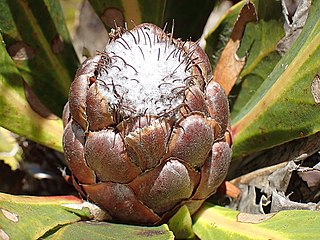
Protea vogtsiae, also known as the Kouga sugarbush, is a small flowering shrub of the genus Protea within the family Proteaceae, which is only found growing in the wild in the southern Cape Region of South Africa.

Protea rubropilosa, also known as the Transvaal sugarbush, escarpment sugarbush or Transvaal mountain sugarbush, is a flowering tree, that belongs to the genus Protea in the family Proteaceae. The plant only occurs in South Africa.

Protea pudens, also known as the bashful sugarbush, is a low-growing, groundcover-like, flowering shrub in the genus Protea. It is only found growing in the wild in a small area in the Western Cape province of South Africa.

Protea susannae, also known as stink-leaf sugarbush, is a flower-bearing shrub of the genus Protea. The plant is endemic to the southwestern Cape Region of South Africa.

Protea angustata, also known as the Kleinmond sugarbush, is a flowering shrub that belongs to the genus Protea. This plant is endemic to the south-west Cape Region of South Africa.

Protea witzenbergiana, or Swan sugarbush, is a flowering shrub of the genus Protea.
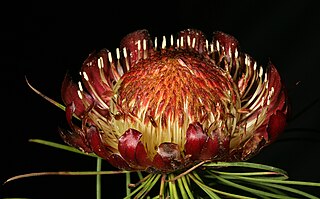
Protea pityphylla, also known as Ceres sugarbush or mountain rose, is a flowering shrub of the genus Protea, in the family Proteaceae. The plant is endemic to the southwestern Cape Region of South Africa.

Protea canaliculata, also known as the groove-leaf sugarbush, is a species of flowering shrub of the genus Protea, which is endemic to the Cape Provinces of South Africa.

Protea lorifolia, in English called the strap-leaved sugarbush, strap-leaved protea or strap-leaf sugarbush is a flowering shrub which belongs to the genus Protea.

Protea decurrens, also known as linear-leaf sugarbush, is a shrub of the genus Protea, in the Proteaceae family, which is endemic to the southwestern Cape Region of South Africa. It is a small shrub with a thick underground rootstock, this structure throwing up numerous leafy branches, upon the base of which clusters of flower heads may appear close to the ground. It is pollinated by rodents and grows in low-altitude fynbos or renosterveld.
























